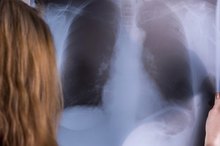Non-Hodgkins Lymphoma Cough Symptoms
Non-Hodgkins lymphoma develops from the rapid, out-of-control growth of cells of the immune system called lymphocytes. Non-Hodgkins lymphoma often begins in the lymph nodes, small organs of the immune system located throughout the body. However, lymphocytes travel all over the body to fight infection, and cancerous lymphocytes can develop in several different organs, including the spleen, liver, lungs and thymus.
Enlarged Thymus
Depending on where in the body non-Hodgkins lymphoma develops, the airways may be affected, which can lead to coughing. Some types of lymphoma develop in the thymus, a small gland that resides in the middle of the chest, just underneath the breast bone. If non-Hodgkins lymphoma occurs in the thymus, it often swells and enlarges. The windpipe, or trachea, runs behind the thymus. In some cases, the thymus swells to the extent that it presses on the windpipe, leading to persistent coughing, according to the American Cancer Society 1.
- Depending on where in the body non-Hodgkins lymphoma develops, the airways may be affected, which can lead to coughing.
Blocked Lymph Vessels
Abdominal Symptoms of Lymphoma
Learn More
Non-Hodgkins lymphoma may also develop in other parts of the chest, such as the lymph vessels that run through the chest, connecting lymph nodes to each other. When non-Hodgkins lymphoma develops in the lymph vessels, it can block these vessels and prevent lymph fluid from passing through them. Blocked lymph vessels can cause fluid to accumulate around the lungs; this is known as pleural effusion. This swelling around the lungs can cause coughing in patients with non-Hodgkins lymphoma, the Merck Manuals reports 2.
- Non-Hodgkins lymphoma may also develop in other parts of the chest, such as the lymph vessels that run through the chest, connecting lymph nodes to each other.
Cancer Treatments
The available treatments for non-Hodgkins lymphoma include radiation treatment and chemotherapy. Both of these treatment options reduce cancer by killing the rapidly growing lymphocytes. However, the treatments may also kill other rapidly growing cells in the body, leading to serious side effects.
Related Articles
References
- American Cancer Society: Non-Hodgkin Lymphoma
- The Merck Manuals: Non-Hodgkin Lymphomas
- Medline Plus: Lymphoma
- Ohio State Cancer Center: Non-Hodgkin's Lymphoma FAQ
- Ansell SM. Hodgkin lymphoma: 2018 update on diagnosis, risk‐stratification, and management. Am J Hematol. 2018;93(5):704-15 doi: https:10.1002/ajh.25071
- Mohseni S, Shojaiefard A, Khorgami Z, et al. Peripheral Lymphadenopathy: Approach and Diagnostic Tools. Iran J Med Sci. 2014 Mar;39(2 Suppl):158-70.
- Bagherania N, Smoller BR. An overview of cutaneous T cell lymphomas. F1000Res. 2016;5:F1000 Faculty Rev-1882. doi:10.12688/f1000research.8829.1
- Fei B, Schuster DM. PET Molecular Imaging–Directed Biopsy: A Review. AJR Am J Roentgenol. 2017 Aug;209(2):255-69. doi:10.2214/AJR.17.18047
- Baron BW, Baron JM. The diagnostic value of biopsy of small peripheral lymph nodes in patients with suspected lymphoma. Am J Hematol. 2012 Feb;87(2):228-30. doi:10.1002/ajh.22240
- Pileri SA, Leoncini L, Falini B. Revised European-American Lymphoma Classification. Curr Opin Oncol. 1995 Sep;7(5):401-7.
- Quintanilla‐Martinez L. The 2016 updated WHO classification of lymphoid neoplasias. Hematol Oncol. 2017 Jun;35(Suppl 1):37-45. doi:10.1002/hon.2399
- Cheson BD. Staging and response assessment in lymphomas: the new Lugano classification. Chin Clin Oncol. 2015 Mar;4(1):5. doi:10.3978/j.issn.2304-3865.2014.11.03
- Al-Naeeb AB, Ajithkumar T, Behan S, Hodson DJ. Non-Hodgkin lymphoma. BMJ. 2018;362:k3204. doi:10.1136/bmj.k3204
- Ansell SM. Hodgkin lymphoma: 2018 update on diagnosis, risk‐stratification, and management. Am J Hematol. 2018;93(5):704-15 doi: https:10.1002/ajh.25071
Writer Bio
Matthew Busse has pursued professional health and science writing since 2007, writing for national publications including "Science Magazine," "New Scientist" and "The Scientist." Busse holds a doctorate in molecular biology from the University of California-San Diego.







